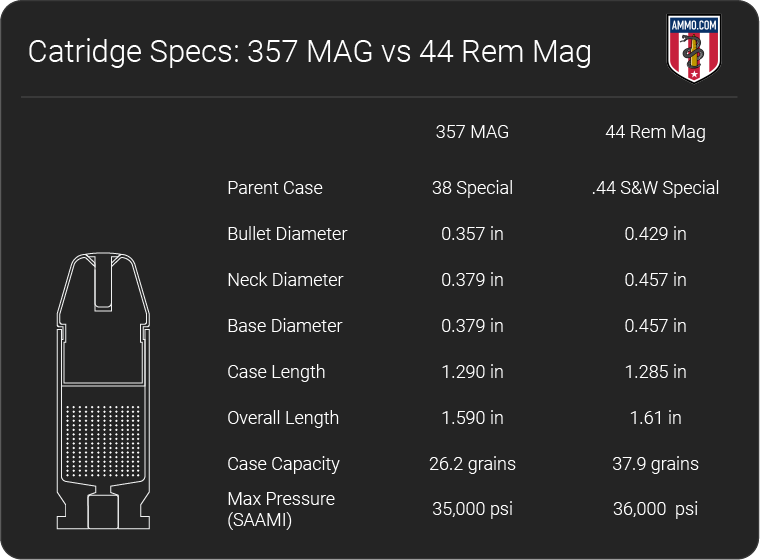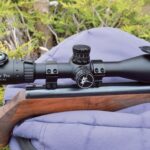 The 357 magnum and the 44 magnum are two of the most iconic rounds in American history.
The 357 magnum and the 44 magnum are two of the most iconic rounds in American history.
Developed for similar reasons by the same individual, it’s no wonder why these rounds have many similarities.
However, the biggest surprise might be the apparent differences when comparing the 357 vs. 44.
Below you’ll find everything you need to know about the 44 magnum and the 357 magnum to choose the best caliber for your situation.
Table of Contents [hide]
- 1 44 vs. 357: How Different Are They?
- 1.1 Cartridge Specs
- 1.2 44 vs. 357 Recoil
- 1.3 Trajectory
- 1.4 357 Mag vs. 44 Mag Accuracy
- 1.5 357 vs. 44 Stopping Power
- 1.6 Hunting With the 44 Mag vs. 357 Mag
- 1.7 357 Magnum vs. 44 Magnum Self-Defense
- 1.8 357 Mag vs. 44 Mag Ammo Cost & Availability
- 1.9 44 Magnum vs. 357 Magnum Gun Availability & Cost
- 1.10 .44 Magnum vs .357 Reloading
- 2 357 vs. 44 Magnum Ballistics
- 3 .357 Development
- 4 .44 Development
- 5 Parting Shots
44 vs. 357: How Different Are They?
Elmer Keith, the man credited for creating both rounds, made the 357 mag first and then took what he learned and created the 44 mag later; however, does this mean the 44 mag is superior?
The differences in each caliber make them better for specific situations.
Even though some may argue otherwise, Elmer Keith did not create the perfect caliber, but if you’re a big-time gun enthusiast, you already knew that.
Both calibers were designed for use in revolvers and found success in lever-action rifles.
Before diving too deep into the 357 magnum, we must bring the 357 Sig to your attention.
The 357 Sig is not a true .357″ bullet; it uses a .355″ (9mm) bullet with a 10mm casing necked down, so it looks like a rifle cartridge.
It was explicitly designed for semi-auto handguns and to have similar ballistics as the 357 mag, which is why Sig Sauger uses the name 357 Sig.
With that out of the way, we can move on to all the crucial differences between the 44 mag vs. 357 mag.
Cartridge Specs
Both rounds are designed to be a rather long handgun cartridge.
The 357 mag round has an overall length of 1.59″, and the straight-walled case makes up 1.29″ of the overall size.
The neck and base diameters are the same at 0.379″, while the bullet diameter is a genuine .357″.
The parent casing of the 357 is a .38 special. So you can shoot .38 special rounds through a gun chambered in 357; however, it does not work the other way around.

Do not attempt to shoot a 357 round through a gun chambered for .38 special.
The 44 mag is also a straight-walled case that’s 1.285 inches long. Once the bullet is set, the total length is 1.61 inches.
The bullet diameter is 0.429″, and the neck and base diameters are .457″.
The 44 S&W Special is the parent case for the 44 magnum, so just like the 357 mag and the 38 special, a 44SPL can be fired from a gun chambered in 44 magnum, but the length of 44 magnum ammo doesn’t allow it to be fired from .44 S&W Special firearms.
44 vs. 357 Recoil
Neither of these calibers is known for their lack of recoil.
With Magnum in the name, you know you better securely hold on to the gun, or it could fly out of your hand.
That’s a bit of an exaggeration, but these rounds do pack a punch.
The gun weight, bullet selection, and shooter factor into the felt recoil.
Everyone agrees the 44 mag has more kick than the 357 mag.
Felt recoil is measured in foot-pounds (ft-lbs); the 44 mag is generally measured at 18.5 foot-pounds of recoil, while the 357 mag is about 11.5ft-lbs of recoil.
While these numbers don’t sound like large numbers, consider the .45 ACP with only 4.5ft-lbs of recoil.
Now we can see why these guns are often so much heavier than others. The weight helps make them more manageable when shooting.
The winner of the recoil section is the 357 mag because of its lighter recoil. However, don’t expect a light kick from a 357 magnum.
Trajectory
These wheel gun calibers weren’t designed for long-range shooting, so the trajectory of each caliber is not impressive once we get past 50 yards.
Their trajectory might flatten some when shooting from a rifle or carbine; however, neither caliber has a tremendous advantage over the other in this category.
357 Mag vs. 44 Mag Accuracy
The accuracy of a round depends on the bullet type, shooter, barrel length, and firearm.
For instance, my grandfather can outshoot me using his Ruger 357 mag. When we switch to his 1911 .45 ACP, I can outshoot him.
In this case, the accuracy doesn’t depend on the caliber; it depends on the shooter.
Someone who can handle more recoil is likely to be more accurate with the 44 magnum.
Once again, each caliber wasn’t designed for hairsplitting accuracy.
By a slight margin, the winner of this round is the 357 magnum because it has less recoil so that the average shooter will be more comfortable with it.
357 vs. 44 Stopping Power
Ask anyone who carries a 357 or 44 mag why they carry such a large caliber, and I guarantee you the answer will be “stopping power.”
If you ask them what this means, they can’t give you a scientific reason, but they’ll probably come back with something along the lines of “bigger bullet = bigger hole”; therefore, it’s more likely to stop a threat.
With today’s ammunition technologies, bigger isn’t always better; the type of bullet and bullet location are two of the most significant factors of stopping power.
Full metal jacket (FMJ) bullets will penetrate more than a hollow point bullet, but the jacketed hollow point (JHP) will cause more damage than the FMJ because it fragments.
The bullet location matters the most because a well-placed .22lr bullet is just as deadly as a well-placed 44 mag bullet.
Now in a high-pressure situation like when your life is on the line, a well-placed shot is not as easy to do as it is on the range. That’s why most people opt for the larger round.
The 44 magnum and the 357 magnum were designed to have increased stopping power over their parent cartridge, and they do.
The 44 magnum will leave a bigger hole in your target because it shoots a bigger bullet.
So if that’s what you’re after, the 44 mag has more stopping power than the 357, which isn’t lacking in stopping power.
Hunting With the 44 Mag vs. 357 Mag
The 44 magnum was intended to be a hunting round. Since its introduction to the civilian market, it’s exceeded expectations.
It’s the primary choice for big game hunters who use a revolver because it can ethically take down any big game animal in North America. Many use a 44 mag as a backup gun for self-defense against brown bears.
It’s also been known to take down elephants, water buffalo, and other African big-game. So to say it’s an adequate hunting caliber is an understatement.
Keep in mind this is a handgun caliber, so that you won’t be making long shots with the 44 mag. You’ll likely be within 50 yards of your target.
Even though the 357 magnum bullet could ethically harvest any big game species in North America, the 44 mag has such a grip on big game hunters the 357 is rarely considered for hunting.
However, if you’re concerned with the amount of recoil a 44 mag has, the 357 mag will be better for hunting.
All things considered, though, the 44 mag is the better hunting caliber compared with the 357 mag.
357 Magnum vs. 44 Magnum Self-Defense
The reason the 357 magnum was created was that the .38 special was not performing well for law enforcement.
The 357 mag made for an excellent self-defense round for many years, and countless people still carry it for self-defense today. Making the 10mm vs 357 magnum argument interesting because many people thought the 10mm would make the 357 mag obsolete.
The 44 mag was designed for hunting and self-defense purposes for big game, not necessarily human threats.
While I would never argue either caliber is lacking in stopping power, there are several other reasons why I advise against using these calibers for home defense or self-defense.
The first is overpenetration.
Because these rounds offer so much stopping power, it takes an immovable object to stop them. So if you happen to miss, which is common in self-defense situations those rounds will go through walls and could injure or kill an innocent bystander.
Even if you hit your target, the rounds can still harm innocents behind the attacker because they’ll over-penetrate.
Another reason I don’t recommend these calibers for concealed carry is that they require a large firearm and large guns are difficult to conceal.
The guns need to be large to balance out the recoil.
Still, another reason why I don’t recommend these calibers is because of the recoil.
The excessive amount of recoil makes it difficult to maintain accuracy when you need to get several shots off quickly.
The final reason I’ll mention for not carrying a 357 mag or 44 mag is because of low ammo capacity. While there are a few semi-automatic handguns chambered in these calibers they’re not common.
Instead, you’ll generally see revolvers, and though revolvers are incredibly reliable, they don’t have the capacity of semi-auto magazines.
Instead of these calibers, I recommend a .45 or 9mm for concealed carry and a 20ga or 12ga shotgun for home defense.
This category is a tie. Neither caliber shines for concealed carry or home defense.
357 Mag vs. 44 Mag Ammo Cost & Availability
Because both rounds are well established, many manufacturers like Remington, Hornady, and Federal make 357 and 44 mag ammunition.
So typically, you have several choices from which to choose. One would think this would help keep the price down, but these magnum rounds come at a magnum price. They generally cost $1.40 per round.
Speaking of prices, check out our check our Remington 357 Magnum ammo and Fiocchi 357 Magnum ammo page for additional ammo options.
Which isn’t ideal for a day of plinking. That could quickly get expensive.
Due to their popularity finding ammo can be difficult. They’re just popular enough that people scoop them up once they hit the shelves but they’re not as popular as 9mm, so ammo manufacturers don’t produce as many of the rounds.
This is another tie between the 44 and 357 mag because ammo cost and availability are virtually the same.
44 Magnum vs. 357 Magnum Gun Availability & Cost
Because the 357 magnum has been around for over 80 years, there are many manufacturers like Ruger, Smith & Wesson, and Colt that offer quality guns chambered in 357 mag. Generally, a reliable snub-nosed revolver will cost you about $1,000.
44 magnum firearms are generally just as abundant and similarly priced. A Ruger Redhawk chambered in either caliber will cost around $1,400.
Henry, Marlin, Winchester, and Rossi all make a levergun chambered for 44 mag and 357 mag. Depending on the brand you purchase, be prepared to spend $500-$1,500.
Both calibers are abundant, so this category is also a tie.
.44 Magnum vs .357 Reloading
Handloading is an excellent way to save money on ammunition if you have the time to invest in crafting special loads.
It’s also ideal for controlling all the variables you can control. Unlike factory ammo, hand-loaded ammo gives you the ability to make each round as close to the other rounds as possible.
This means more accurate and consistent ammo, ideal for target shooting and self-defense situations.
Both calibers have existed long enough that reloading supplies and equipment are readily available.
My grandpa used to handload 357 magnum ammo all the time. He would tinker with heavier bullets and varying powder amounts to craft his special ammo for concealed carry or for range day he might go with a light bullet and less powder that way the recoil wouldn’t be as bad.
For 44 magnum lovers, it’s also the same. They’ll spend countless hours perfecting their special loads for hunting by increasing or decreasing bullet weight to gain more muzzle energy.
This section is another tie because these two rounds are readily available to handload, and many shooters enjoy reloading both calibers.
357 vs. 44 Magnum Ballistics
The dedicated team at Ammo.com crafted ballistics charts for you to reference quickly. Check out the ballistics tables below for each caliber!
357 Ballistics
Note: This information comes from the manufacturer and is for informational purposes only. The actual ballistics obtained with your firearm can vary considerably from the advertised ballistics. Also, ballistics can vary from lot to lot with the same brand and type load.
44 Ballistics
Note: This information comes from the manufacturer and is for informational purposes only. The actual ballistics obtained with your firearm can vary considerably from the advertised ballistics. Also, ballistics can vary from lot to lot with the same brand and type load.
.357 Development
The .357 Magnum was the first magnum handgun caliber. It was developed in 1935 by Elmer Keith as an improved replacement for the .38 special to fight against bootleggers and gangsters wearing ballistic vests.
The S&W Model 27, a .357 Magnum revolver, went into production, and the first one to leave the factory was given to J. Edgar Hoover. It was immediately a favorite of law enforcement and is still loved by many concealed carriers.
After its release, the .357 Mag held the title of the world’s most powerful handgun cartridge for 20 years.
The U.S. military used this caliber from World War II through Vietnam. For years, .357 revolvers were on the hips of police officers, security guards, and U.S. special forces.
Decades after revolvers were replaced by semi-automatic pistols, short-barreled .357 Mags offer backup to those who protect and serve.
.44 Development
Elmer Keith also developed the .44 Magnum cartridge. He wanted to create a cartridge based on a .44 caliber bullet that would be better for handgun hunting. Elmer made high-pressure loads that pushed a heavy grain bullet faster than what was available in ammunition with this size of a bullet.
He worked with Smith & Wesson and Remington to bring about the Model 29 and ammo.
Even though the ammunition started with Smith & Wesson and Remington, Ruger beat them to the punch because of a silly mistake.
A Sturm, Ruger & Company employee found .44 magnum cases at a scrapyard and correctly concluded their competitors were making a new gun and caliber. Ruger quickly designed and produced the iconic single action .44 Magnum Blackhawk revolver in 1956.
Since then, the 44 mag has proven itself as a viable handgun hunting round and still remains the choice for many hunters entering bear country.
Parting Shots
These two calibers are eerily similar when we break them down, which shouldn’t surprise us since the same individual created them for similar purposes.
However, if you were keeping track, then you know the .44 Magnum barely edged out the .357 Magnum.
Keep in mind that both calibers have established their place in history and don’t appear to be fading out of history anytime soon.
When comparing the 357 vs. 44, it’s a close one and depends on your purposes; if hunting big game, the .44 mag is tough to beat, but the .357 mag is a better choice for self-defense.















































